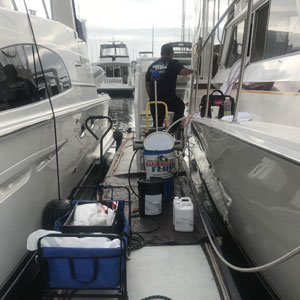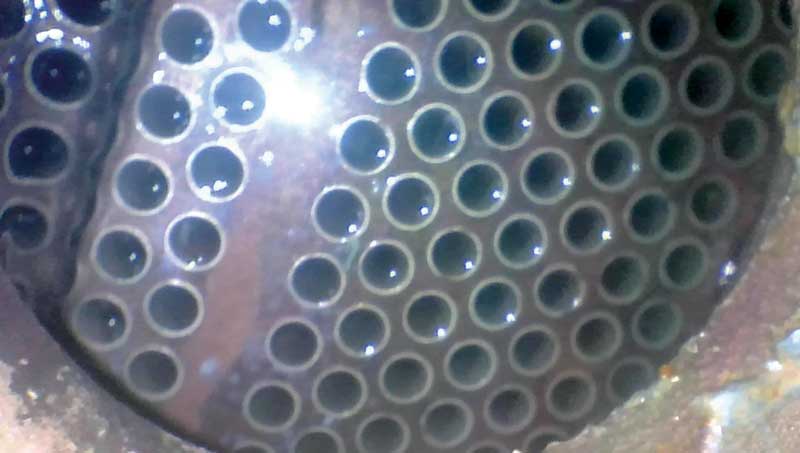Marine Cooling Service: Protecting Your Engine
Expert Maintenance Guide

I. Introduction
Welcome aboard, fellow boating enthusiasts! If you’re passionate about marine adventures, you know how crucial it is to keep your engine running smoothly and efficiently. In this article, we’ll explore the vital role of marine cooling systems and how proper maintenance, including the use of marine cooling service, can ensure optimal performance and prevent costly damage. So, let’s set sail on this informative journey!
II. Understanding the Impact of Poor Water Flow
Consequences of inadequate water flow to the engine: When your marine cooling system fails to provide sufficient water flow, it jeopardizes the engine’s ability to maintain an optimal operating temperature. This can lead to a chain reaction of problems, resulting in reduced performance, increased fuel consumption, and ultimately, engine overheating.
Engine overheating as a result of cooling inefficiency: Engine overheating is not just a minor inconvenience; it’s a serious issue that can cause significant damage. The cooling inefficiency caused by poor water flow restricts the engine’s ability to dissipate heat effectively, leading to excessive temperatures and potential engine failure.

Potential damage and associated repair costs: Ignoring the importance of maintaining your marine cooling system can lead to severe damage. The high temperatures can cause warping, cracking, or even seizing of vital engine components, such as the cylinder head, pistons, or bearings. Repairing or replacing these components can result in costly bills that can reach thousands of dollars.
Downtime implications for marine operations: Engine overheating not only leads to financial implications but also disrupts your valuable time on the water. Extended periods of downtime for repairs can put a damper on your boating adventures and lead to frustration. That’s why investing in regular maintenance, including a marine cooling service, is essential to keep your engine running smoothly.
III. The Importance of Flushing the Seawater System
A detailed explanation of the flushing process: Flushing the seawater system is a key step in maintaining your marine cooling system’s efficiency. The process involves introducing an environmentally safe flushing solution into the system, which effectively removes marine growth, mineral deposits, and any other obstructions that hinder water flow.
Benefits of flushing in removing marine growth: Marine growth, such as barnacles and algae, can accumulate within the cooling system over time. These organisms restrict water flow, reduce cooling efficiency, and contribute to corrosion. Flushing the system eliminates this marine growth, preventing further damage and ensuring optimal cooling performance.
Protection of metal and rubber seals: One concern many boaters have when flushing their cooling system is the potential harm to metal or rubber seals. However, with the use of an environmentally safe flushing solution, this worry is eliminated. The solution is specifically designed to be gentle on the system’s components while effectively removing deposits and growth.
Ensuring proper water flow for optimal engine performance: The primary objective of flushing the seawater system is to restore and maintain proper water flow. By eliminating obstructions, the cooling system can effectively regulate the engine’s temperature, ensuring optimal performance and efficiency.



IV. Step-by-Step Guide: Marine Cooling Service Procedure
Let’s delve into the step-by-step process of marine cooling service, giving you a clear understanding of what to expect when opting for this maintenance solution.
Step 1: Preparing the vessel and cooling system for flushing:
This step involves ensuring the engine is turned off, disconnecting the seawater intake, and preparing the necessary tools and equipment for the service.
Step 2: Introduction of the environmentally safe flushing solution: The marine cooling service professional will carefully introduce the specially formulated flushing solution into the seawater system, targeting the areas prone to marine growth and deposits.
Step 3: Flushing the seawater system: With the solution in place, the service provider will initiate the flushing process, allowing the solution to circulate throughout the cooling system. This step effectively removes marine growth, sediment, and other contaminants, restoring optimal water flow.
Step 4: Verifying proper water flow and system functionality: Once the flushing process is complete, the service provider will verify the restored water flow and system functionality. This ensures that the cooling system is operating at its best and that potential issues are identified and addressed promptly.
Step 5: Post-service maintenance recommendations: To maintain the longevity and performance of your marine cooling system, the service provider may offer valuable post-service maintenance tips. These recommendations may include regular inspections, scheduled flushing intervals, and additional steps to optimize the system’s performance.
V. Frequently Asked Questions (FAQs)
Maintaining the marine cooling system is crucial as it ensures proper engine cooling, preventing overheating and potential damage.
Inadequate water flow restricts the engine’s cooling efficiency, leading to increased temperatures, reduced performance, and potential engine failure.
Signs of engine overheating include steam or smoke from the engine compartment, high engine temperature readings, and unusual noises or vibrations.
Yes, engine overheating can cause long-term damage, including warping, cracking, or seizing of vital engine components, resulting in costly repairs.
Marine cooling service focuses specifically on optimizing the cooling system, offering a cost-effective and targeted solution, while traditional mechanical service covers a broader range of mechanical maintenance and repairs for various engine components.
The environmentally safe flushing solution is designed to effectively break down and remove marine growth, mineral deposits, and contaminants without causing harm to metal or rubber seals. It provides a gentle yet thorough cleaning of the cooling system.
No, the flushing process is specifically formulated to be safe for metal and rubber seals. It effectively cleans the system without causing any damage or deterioration to these components.
Regular maintenance is recommended to ensure optimal performance. Depending on usage and environmental conditions, it is generally advisable to schedule a marine cooling service annually or as recommended by the manufacturer.
Yes, to maintain the longevity and performance of your marine cooling system, consider implementing regular inspections, monitoring water flow, checking for leaks, and adhering to the manufacturer’s recommended maintenance schedule.
While basic maintenance tasks such as visual inspections and cleaning the exterior of the system can be done by boat owners, a professional marine cooling service is recommended for a thorough cleaning and ensuring proper functionality. It guarantees the use of specialized equipment, expertise, and environmentally safe solutions.
VI. Conclusion
Smooth sailing is essential for any boating enthusiast, and maintaining your marine cooling system plays a pivotal role in ensuring a safe and enjoyable experience. By understanding the impact of poor water flow, recognizing the benefits of marine cooling service, and embracing regular maintenance, you can safeguard your engine, prevent costly repairs, and maximize your time on the water.
Remember, investing in a marine cooling service is a proactive approach that protects your engine from the damaging effects of overheating. By flushing the seawater system with an environmentally safe solution, you remove marine growth, optimize water flow, and keep your engine running at its best.
So, don’t wait until a problem arises—schedule a marine cooling service today and embark on worry-free boating adventures, knowing that your engine is well-protected and your cooling system is optimized for peak performance. Happy boating!

